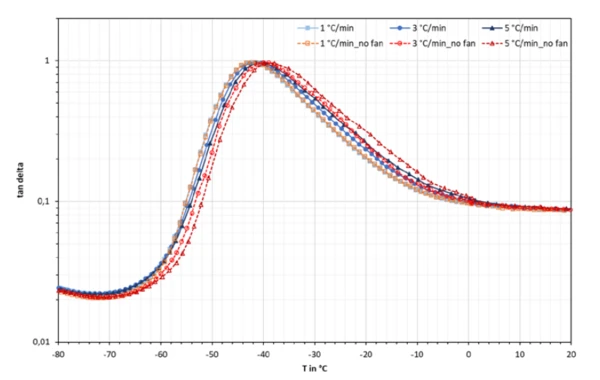Introduction
Thanks to their high elasticity and adjustable damping behavior, elastomer materials are used in almost all technical fields. However, the unique rubber elasticity is dependent on temperature. The temperature behavior of elastomer materials is determined by temperature sweeps. Temperature sweeps are clearly parameterized with heating and cooling rates as well as initial and final temperatures. Experimentally, reliable determination of the temperature behavior requires precise temperature control and a low temperature gradient within the measuring chamber. In order to ensure excellent temperature distribution within the measuring chamber, the measuring chamber of the DMA GABO Eplexor® series comes standard with a fan.
In this application note, the influence of the temperature distribution in the DMA GABO Eplexor® series is investigated. To this end, temperature sweeps were performed within a certain temperature interval both with and without a fan.
Measurement Results
Six temperature sweeps on samples of the same rubber mixture were carried out with the DMA GABO Eplexor® 500 N from -80°C to 20°C at heating rates of 1, 3 and 5 K/min. To check the influence of the chamber fan on the temperature distribution in the measuring chamber, the three temperature sweeps were carried out with and without chamber fan. Figure 1 shows the heating-rate dependency of the loss factor, tan δ, measured with and without chamber fan.

Figure 1 substantiates that the Glass Transition TemperatureThe glass transition is one of the most important properties of amorphous and semi-crystalline materials, e.g., inorganic glasses, amorphous metals, polymers, pharmaceuticals and food ingredients, etc., and describes the temperature region where the mechanical properties of the materials change from hard and brittle to more soft, deformable or rubbery.glass transition range is dependent on both the heating rate and the use of a chamber fan. In order to investigate this behavior in more detail, the Glass Transition TemperatureThe glass transition is one of the most important properties of amorphous and semi-crystalline materials, e.g., inorganic glasses, amorphous metals, polymers, pharmaceuticals and food ingredients, etc., and describes the temperature region where the mechanical properties of the materials change from hard and brittle to more soft, deformable or rubbery.glass transition temperature, Tg – defined as the maximum of the loss factor, tan δ – is depicted in figure 2 as a function of the heating rate and the use of a fan.
Figure 2 shows that the Tg shifts to higher temperatures with higher heating rates, irrespective of the use of a fan. The shift that is a function of the heating rate can be explained by the lower Thermal ConductivityThermal conductivity (λ with the unit W/(m•K)) describes the transport of energy – in the form of heat – through a body of mass as the result of a temperature gradient (see fig. 1). According to the second law of thermodynamics, heat always flows in the direction of the lower temperature.thermal conductivity of most plastics. Material-specific transition effects, such as RelaxationRelaxation은 고무에 일정한 변형률이 가해지면, 변형률을 유지하기 위해 필요한 힘은 일정하지는 않지만 시간에 따라 감소합니다. 이러한 특성을 ‘응력 완화’라고 부릅니다. 응력완화의 원인이 되는 과정은 물리적 또는 화학적 그리고 정상적인 조건 하에, 둘 다 동시에 일어날 수 있습니다. relaxation or Glass Transition TemperatureThe glass transition is one of the most important properties of amorphous and semi-crystalline materials, e.g., inorganic glasses, amorphous metals, polymers, pharmaceuticals and food ingredients, etc., and describes the temperature region where the mechanical properties of the materials change from hard and brittle to more soft, deformable or rubbery.glass transition temperatures, are shifted since the samples lag behind the furnace temperature.
Between the measurements at heating rates of 1 K/min and 5 K/min, the Tg shifted by less than 1°C, i.e. extremely insignificantly, when using a chamber fan. Without a chamber fan, the shift in the Glass Transition TemperatureThe glass transition is one of the most important properties of amorphous and semi-crystalline materials, e.g., inorganic glasses, amorphous metals, polymers, pharmaceuticals and food ingredients, etc., and describes the temperature region where the mechanical properties of the materials change from hard and brittle to more soft, deformable or rubbery.glass transition temperature, Tg, amounted to approx. 4°C. Thus, the chamber fan promotes a very good temperature distribution in the measuring chamber; this allows for the shift in the Glass Transition TemperatureThe glass transition is one of the most important properties of amorphous and semi-crystalline materials, e.g., inorganic glasses, amorphous metals, polymers, pharmaceuticals and food ingredients, etc., and describes the temperature region where the mechanical properties of the materials change from hard and brittle to more soft, deformable or rubbery.glass transition temperature to be attributable solely to the low Thermal ConductivityThermal conductivity (λ with the unit W/(m•K)) describes the transport of energy – in the form of heat – through a body of mass as the result of a temperature gradient (see fig. 1). According to the second law of thermodynamics, heat always flows in the direction of the lower temperature.thermal conductivity of elastomer composites.

Summary
As a result, the measurement times for temperature sweeps carried out by instruments of the DMA GABO Eplexor® series can be shortened by using higher heating rates, thanks to the good temperature distribution in the measuring chamber. A temperature sweep at a heating rate of 5 K/min will take about one-fifth of the measurement time of a temperature sweep at a heating rate of 1 K/min.